Put your arms up! Sometimes there’s no better thrill than a roller coaster ride – and if you’ve never been on one, you’ve at least stared at one in terror.
But did you ever wonder where they come from? How did we get the idea to send people around a twisty track for fun? Roller coaster history goes back farther than you may think: Since before that apple hit Isaac Newton on the head, we’ve been playing with gravity.
Russian Mountains
Considered to be the forefathers of the modern roller coaster, the Russian Mountains of the 16th and 17th centuries were tall wooden slides covered in ice and snow. These slides could be as high as 70 feet, and people would use ordinary sleds (or ice blocks) to slide down. Catherine the Great even had a Russian Mountain custom-built for one of her residences. At some point, carts with wheels were added so that people could enjoy the “mountains” no matter the time of year or climate. In the 1800s, Russian Mountains became popular even outside of Russia and spread across Europe, becoming especially beloved in France.
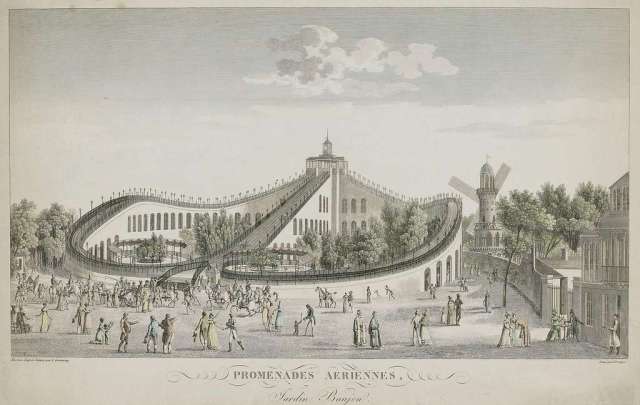
The First Coasters
There is some dispute over what counts as the “first roller coaster.” There’s even a rumor that the first coaster was the previously-mentioned Russian mountain commissioned by Catherine the Great. Some believe roller coaster history began with the 1817 Les Montagnes Russes a Belleville, or “The Russian Mountains of Belleville,” that had two tracks with carts attached so that the cars could “race” each other. Others believe it was the 1817 Promenades Aeriennes, or “The Aerial Walk.” Its 600-foot track could send carts at speeds of up to 40 miles per hour. It had a pair of complete-loop tracks, which meant that the tracks could circle around and finish at the place where it had started. It also had carts that were locked to the tracks and even featured a lift mechanism, which premiered some time after the ride first opened.
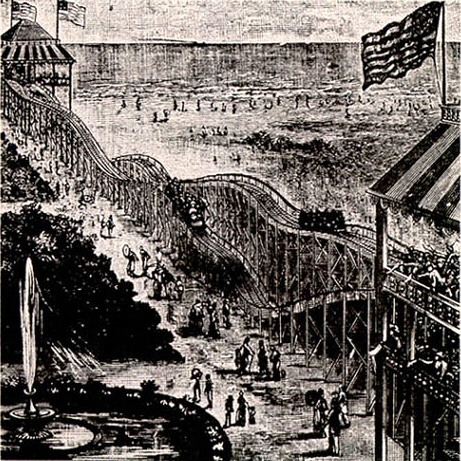
Roller Coaster History in America
America’s first coaster-like attraction was Pennsylvania’s Mauch Chunk Switchback Railroad, which opened in 1873. The Mauch Chunk Switchback Railroad was a repurposed coal mine that took visitors on a leisurely journey up the side of a mountain before dropping them back down for a rollicking ride powered only by the terrifying rush of gravity. It was a pretty long ride, too, at over 18 miles. Let’s hope people were holding onto their hats.
In 1884, LaMarcus A. Thompson opened the Gravity Switchback Railway at Coney Island. It wasn’t built into the side of a mountain – rather, it was a wooden structure where guests sat on benches and traveled back and forth down a series of gentle hills. It was five cents per ride, traveled just over 6 miles per hour and was a massive success. The popularity of the Gravity Switchback Railway led to a proliferation of switchback railway style roller coasters across the country.
You might think that roller coasters with inversions are a modern invention, but that’s not exactly the case. In 1899, one of America’s first vertical-looping roller coasters, the Flip Flap Railway, was invented by Lina Beecher. It operated for only three seasons in Coney Island, since the incredibly intense G-force caused some riders to injure their necks or even faint. This is thought to have been caused by the completely circular vertical loops – modern-day coasters have more teardrop-shaped loops for a less intense effect. Though others at the time tried to improve on the design, people eventually stopped producing vertical-looping coasters until the mid-70s.
As coasters became more popular, the pace of innovation surged. Roller coasters shifted away from scenic rides and leaned more into producing excitement and thrills, thanks in large part to the underfriction design patented in 1919 by John Miller. This design allowed for vehicles to lock to the tracks with less friction, leading to safer and faster rides.
The early 1900s, especially the period from 1919-1929, are a golden age on the roller coaster history timeline, as new wooden coasters and coaster designs were regularly produced until the Great Depression. During this golden age, over 2,000 roller coasters were built, though few of them survive today. The 1927 Cyclone at Coney Island is a notable survivor from this period.
Modern Roller Coasters
One of the first big breakthroughs in modern coaster design happened at the happiest place on Earth. Disneyland’s Matterhorn Bobsleds, which opened in 1959, introduced a tubular steel track which allowed the roller coaster to bend and loop without the limits of a wooden coaster track. It was designed as a collaboration between Arrow Development and WED Imagineering. Arrow Development went on to become a major designer and manufacturer in the roller coaster world.
Roller coasters experienced a resurgence in popularity in the 1970s, when the Racer at Kings Island was featured on a 1973 episode of The Brady Bunch. A 1977 film called “Rollercoaster” also cemented the roller coaster’s place in popular culture.
In 1975, the first modern coaster with a vertical loop opened at Knott’s Berry Farm. This steel coaster, featuring a corkscrew design, led to the proliferation of coasters with vertical loops.
Over the years, people have continued to design and iterate new roller coaster features for riders to enjoy. Today, roller coasters can loop-the-loop, spin you around, dangle your feet, imitate motorcycles, stand you up, go backwards and even incorporate augmented reality elements. The next time you get on a roller coaster and strap in, remember that it all started with an ice slide.
Do you have a favorite roller coaster? Do you prefer steel or wooden coasters? Tell us in the comments below.
If you like roller coasters, you might enjoy more theme park stories.
21 Thoughts on “A Thrilling Ride Through Roller Coaster History”
Leave A Comment
Comments are subject to moderation and may or may not be published at the editor’s discretion. Only comments that are relevant to the article and add value to the Your AAA community will be considered. Comments may be edited for clarity and length.



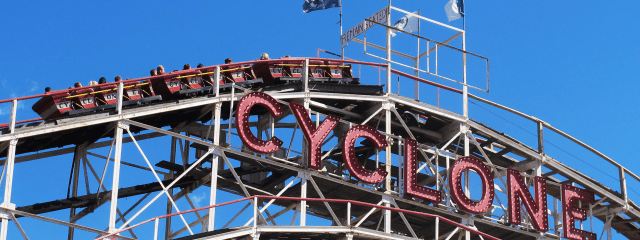
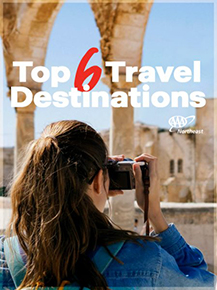



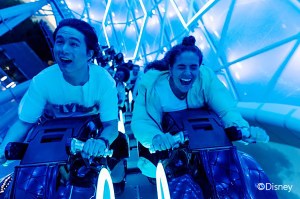

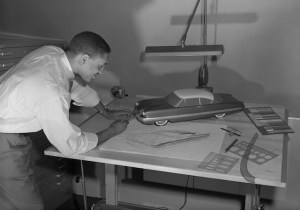

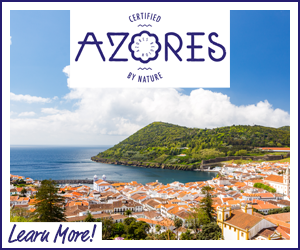


Science fiction film buffs will recall the climatic scene in 1953’s The Beast From 20,000 Fathoms, where the title character is destroyed at a roller coaster attraction in Coney Island. I’ve read that the scene was actually shot at The Pike amusement park roller coaster – coincidentally named Cyclone Racer – in Long Beach, CA
Recently made a pilgrimage to Coney for the Mermaid Parade, and of course had to ride the Cyclone, just as thrilling as it was when I rode it in ‘67. Really wish they still operated the parachute since the structure remains!
Props to AAA on a great article – you got it right on all those major historical milestones. Nice to read a well-researched article that isn’t just “what’s tallest this year?”.
The Cyclone at Coney Island in Brooklyn. Best thrills and my hometown roller coaster!
My favorite roller coasters are Thunder Mountain in Disney and the Big Bad Wolf in Busch Gardens in Virginia.
I remember the wooden roller coaster in the 1950’s and 60’s at Paragon Park in Hull, MA.
My God…. I grew up on the South Shore and remember that park and roller coaster well. I believe that roller coaster was dismantled and reassembled at another amusement park in Maryland.
The first coaster I rode was the Cyclone at Revere Beach. When that closed we went to Paragon park at Nantasket Beach. That one didn’t close until 1984. Maybe I ran into you there. LOL
Palisades Amusement Park was famous, located in NJ along the Hudson River and memorialized in a song in the 1960-1960s. It had a fast and scary roller coaster.
Bertrams Island amusement park on Lake Hopatcong in New Jersey had a roller coaster. It was not the highest, nor the fastest, but very old, from the 1920,s, and in ill repair. The thrill of the ride was not knowing if the whole thing would collapse or not. As the cars rounded each curve, the whole structure would sway! As you rode up and down the hills you could feel the wood beams sagging and rebounding. Unfortunately the park closed about 50 years ago and is now townhouses.
As a kid in Pittsburgh in the ’60’s, every school had a Picnic Day at Kennywood Park, and the 3 rollercoasters were definitely the highlight!
The Cyclone is a fun ride. There was also the Bob Sled and Thunderbolt which are not there anymore.
Le Monstre is a wooden roller coaster at La Ronde amusement park in Montreal, Quebec, Canada.
Le Monstre is the largest wooden roller coaster in Canada and is also the tallest two-track wooden roller coaster in the world.
Old and rickety-loved every terrifying minute!
Superman, the mind eraser and the black widow all at Six Flags in Agawam Ma
The coaster at Palisades Park in New Jersey.
The Rye Beach (Rye, NY) Playland Amusement Park hosts “The Dragon Coaster” which is a 1920s era wooden roller coaster. I operated it in n the 1970s and rode it countless times. The rides only got better time after time!
THE CYCLONE IN CONEY ISLAND
Growing up in Brooklyn, NY, riding the Cyclone was not only a blast, it was a right of passage. To stay for another pass, all you had to do at the end of the ride was hold up your money and off you went after collecting a bunch of new passengers. It became a thing to try and set records for how many consecutive rides you could endure. The secret to success was to eat your Nathan’s hot dog after you finished and NOT before! 🙂
Indeed, one of the best things about the Cyclone was the repeat ride option. During the years the Alberts ran the ride, you could often bargain on the re-rides, especially on not-busy weekdays. At the time a ride was $3.50, the best deal I got was 11 re-rides for a $20 payment. Cash was king in those days. Now you aren’t even allowed to wait for a preferred seat. Still the king of coasters, though.
Kennywood Park near Pittsburgh!
In the early ’60s, I worked at Olympic Park in Maplewood NJ. The fabulous roller coaster, The Jet, was quite popular. Every morning, my cousin and I would tie on our aprons filled with hammer screws and carrying a small sledge hammer, we would walk the entire length of the wooden track, replacing missing hammer screws in the steel tracks. Not a job for anyone afraid of heights !